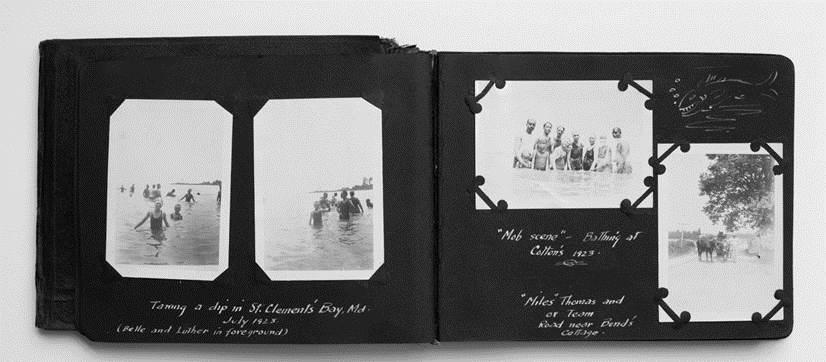This blog was adapted from the latest edition of our Washington History magazine series “On the Shelf: Sadgwar Family Papers Scrapbook, 1923, MS 0817,” by Collections Manager Autumn Kalikin.
You can read her unabridged article in the spring 2023 issue of Washington History magazine.

The DC History Center’s collections house many family papers and scrapbooks, revealing the highs, lows, and in-betweens of domestic life in the District. Washington’s vibrant and diverse households, past and present, leave their stories behind in remarkable, everyday ways.
One such scrapbook belonged to the Sadgwar family: an elite, early 20th-century Black Washington household whose patriarch, G. Luther Sadgwar, used his artistic skill and wit to preserve meaningful memories. Vacation photos, candid snapshots, and posed portraits are nestled among careful calligraphy and illustrations, giving us a glimpse into the lives of this extraordinary family.
Growing up in DC, G. Luther Sadgwar attended the Washington Normal School No. 2. When he graduated in 1904, Sadgwar was already well known for his artistic talent, rendering caricatures of classmates and writing plays. His “comic opera” titled “The Isle of Never” premiered on June 3, 1907, at the True Reformer Building on U Street.[1]
Sadgwar held positions at Howard University and the London School of Cartooning and Illustration. By 1920 he was deeply beloved as an art teacher at Shaw Junior High School. Involved in his community, Sadgwar was elected president of the Mu-So-Lit Club in 1913, a social club of educated Black men in DC, which acted as a unifying force for generations of the District’s upper class Black community, of which the Sadgwars were well-known members.[2]

Over the years, G. Luther Sadgwar collected photographs of his family swimming, playing tennis, riding horses, and modeling the latest 1920s fashion. In the scrapbook’s pages, fun family vacations mix with formal occasions, all punctuated by Sadgwar’s cartoon illustrations and humorous captions cut from magazines. The pages also capture the wonder of everyday moments, such as a photo of a porch cat cheekily captioned “the local milkman.” Together, this whimsical collection of images and illustrations creates a captivating snapshot of one family’s life.
The rest of the Sadgwar family was equally involved in DC’s elite Black social scene. Emma Stark Sadgwar, G. Luther’s wife, was a teacher in the Baltimore public school district and later worked at the Government Printing Office. Their children, Belle and Luther Tucker Sadgwar, were charming and accomplished. Belle was a socialite, beloved by her peers and instructors alike. Her Graduate Book from Dunbar High School (Class of 1928) overflows with notes from friends, lists of clubs, and hopes for the future. Luther Tucker joined the military as a dental technician and regularly corresponded with his mother, Emma, while stationed in France during World War II. Luther’s wartime letters to Emma are witty and familiar. These items are also part of the DC History Center’s collection.
Many of the photos in the Sadgwar family scrapbook are dated 1923, the year G. Luther Sadgwar died unexpectedly of heart complications at age 39. The patriarch’s sudden death left his family and local communities reeling. Tragically, Belle Sadgwar also died young after an operation for acute appendicitis at only 19.[3] With most of its photographs depicting their final summer together, the Sadgwar scrapbook captures blissful moments before unforeseen tragedy. It is a bittersweet relic of an extraordinary family—and a reminder of the beautiful and complex stories waiting to be unearthed in local archives.
This collection was cataloged by the DC Africana Archives as part of a grant initiative of the George Washington University Libraries supported by the Council on Library and Information Resources. The Sadgwar Family Papers are available for reference at the Kiplinger Research Library, by appointment.
Interested in more collections like this? Here are a few more examples of family papers and scrapbooks in the DC History Center’s collection:
[1] “Class of Normal School No. 2,” Evening Star, Jan. 31, 1907; “Afro-Americanism,” Seattle Republican, Apr. 5, 1907.
[2] Mary Church Terrell, Mary Church Terrell Papers: Speeches and Writings, 1866-1953; Undated; Testimonial to Luther Sadgwar, loc.gov/item/mss425490625/.
[3] Anna J. Cooper, “Belle Sadgwar,” Published Materials by Anna J. Cooper, dh.howard.edu/ajc_published/4.